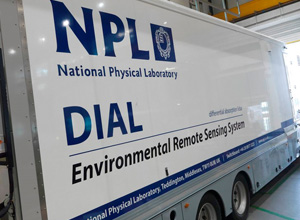May 31 2014
The Environmental Measurements Group and the Centre for Carbon Measurement at the National Physical Laboratory (NPL) have launched a new mobile laboratory to detect and measure emissions that are harmful to the environment.
 The new DIAL facility at NPL
The new DIAL facility at NPL
The DIAL (Differential Absorption Lidar) facility is a sophisticated laser-based system that provides rapid, accurate measurements of airborne emissions. It is a completely self-contained mobile laboratory that can shipped, or driven, to where it is needed.
NPL’s current DIAL system has been used successfully by both regulators and companies to measure leaks from industrial sites, for example monitoring oil and gas emissions in Norway, benzene emissions in the Port of Rotterdam and methane leaks from landfill sites for Defra in the UK.
The new, next-generation facility has been built thanks to over £1 million investment by NPL and support for the underpinning science from the National Measurement Office, an executive agency of the Department for Business, Innovation and Skills. It will be used around the world to quantify and visualise emissions from industrial sites, informing operational efficiency improvements, reducing losses and supporting research and policy developments. Innovations include greater detection sensitivities that offer more accurate results, and a flexible system that enables operators to switch between the types of pollutants being measured.
This unique service that NPL offers globally creates 3D emission maps of various pollutants like airborne hydrocarbons. With faster deployment as well as more efficient data manipulation and usage through an improved software system, it delivers quicker results for customers.
Identifying emissions leaks and doing something to prevent them will reduce the environmental impact of the companies that use it, but also deliver clear commercial benefits. For example, methane has an economic value and preventing methane leaks means there is more gas to sell.